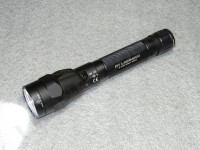 Designed specifically for law enforcement duty, the compact SureFire R1 Lawman is the first of SureFire’s rechargeable LED lights to be released and includes a new high-output LED, high capacity lithium-ion battery for increased runtime, and user-programmable head and tail switches. Maximum output for the R1 Lawman is an impressive 750 lumens and optional medium and low modes provide up to 37 hours of runtime.
Designed specifically for law enforcement duty, the compact SureFire R1 Lawman is the first of SureFire’s rechargeable LED lights to be released and includes a new high-output LED, high capacity lithium-ion battery for increased runtime, and user-programmable head and tail switches. Maximum output for the R1 Lawman is an impressive 750 lumens and optional medium and low modes provide up to 37 hours of runtime.
Find out more about this performance-packed rechargeable duty flashlight in our exclusive review of the new SureFire R1 Lawman!
Key Specifications
- Output: 750 lumens high, 150 lumens medium, 15 lumens low
- Intensity: 16,000 candela
- Runtime: 1h 45min high, 5h 15min medium, 37h low
- Battery: Lithium-Ion Rechargeable Battery Pack (2,900mAh) or 2 x 123A
- Length: 8.1″
- Diameter: 1.6″ bezel, 1.1″ body
- Weight with Batteries: 10.2 oz.
- Warranty: Limited Lifetime
- MSRP: $455
- Actual Pricing: ~$350
Pricing & Ordering
MSRP for the R1 Lawman is $455, and the light is only available in black. Several retailers already have the R1 Lawman in stock, and actual pricing is estimated to be around $350.
In The Box
We received our R1 Lawman in pre-production packaging, but production models will come in a cardboard box with similar contents, including: SureFire R1 Lawman, Lithium-Ion rechargeable battery pack, “Dual Fuel” battery carrier with 2 x SF123A batteries installed, AC adapter with international adapters, 12V car charger, rubber anti-roll ring, and user manual.
Batteries
One of the many improvements that the R1 Lawman received during its development was a new, higher-capacity, battery pack. With Panasonic’s Nickel-Oxide New Platform (NNP) technology, the proprietary rechargeable lithium-ion battery pack has an increased capacity of 2900mAh and is rated for 500 full discharge cycles with a 20% loss in capacity (up to 2000 cycles with partial discharge cycles).
To charge the light, connect the AC adapter to the charge port on the light. When the Fuel Gauge LED turns green, the battery is charged to 90% capacity. Typical charge time until 90% is two hours, and it will take an additional two hours to reach 100% capacity. For maximum battery longevity, as mentioned above with the cycle count, you may want to consider only charging the battery to 90%.
While rechargeable systems are cost-effective and convenient, most can only be powered by the rechargeable battery pack, leaving you in the dark if the rechargeable battery is depleted. With “Dual Fuel” capability, the R1 Lawman stands among the few rechargeable flashlights that can also use regular disposable batteries – in this case, 2 x 123A lithium primaries (rechargeable lithium-phosphate batteries are not supported).
If the battery type is changed, or depleted primaries are replaced with new ones, the Fuel Gauge requires a reset by briefly pressing the tail switch.
The Light
Head
Behind the crenelated bezel are an anti-reflective coated glass window and a textured reflector. Flat areas on the head stop the light from rolling away on a smooth surface.
Raised texturing of the SureFire logo on the rubber cover gives tactile feedback for the electronic head switch.
Body
The body is type-III anodized to resist scratches and corrosion, and aggressive knurling along the body of the light provides grip.
Next to the water-resistant charge port is the Fuel Gauge LED, which indicates battery charge status during use and while charging. Green indicates at least 90% charge, orange indicates reduced battery charge, red indicates low battery, and blinking red indicates that it’s time to charge or replace the batteries.
Tail Cap
On the tail cap is a tactical “press for momentary, twist for constant on” switch. To prevent accidental activation in a tactical situation, the tail switch has a raised border and requires more pressure to activate than a regular clicky or electronic switch.
To activate the lockout tailcap feature, unscrew the tail cap until the light no longer turns on (about a half-turn). The light can still be activated by the head switch if the tailcap is locked out.
Modes
Four modes, which are arranged into three function sets, are available for the user to choose from. If multi-mode operation is selected, the head switch will activate the previously used mode.
High
100% mode for 750 lumens. Always accessible from the tail switch, independent of the head switch.
Medium
20% mode for 150 lumens.
Low
2% mode for 15 lumens.
Strobe (Tail Switch Only)
With three consecutive presses or twists, the 750 lumen strobe is activated.
Function Sets
To change the function set, twist the tail cap for constant on and hold the head switch until the light turns off. Unscrew the tail cap, and the R1 is now in the next program set.
Program 1 (Default)
Head Switch: High, Medium, Low, Off
Tail Switch: High Only
Program 2
Head Switch: High, Medium, Low, Off
Tail Switch: High and Strobe
Program 3
Head Switch: High Only
Tail Switch: High Only
When using program 1 or 2, we found a good balance of output and runtime if medium output is programmed in memory for the head switch since maximum output is always accessible from the tail switch should it be needed.
Performance
Using the same high-performance Cree XM-L LED found in the P2X Fury, the R1 Lawman raises the bar once again with its maximum output of 750 lumens, equivalent of a typical 60W incandescent bulb. This combination of a large-die LED with a textured reflector produces a smooth, flawless beam that will light up just about anything.
Due to the electronic head switch and memory feature, the R1 Lawman has a standby drain of 200 µA (or 0.2 mA). Even though this is a fairly significant standby drain compared to other lights, it will take 1.6 years to drain the 2900mAh battery, so we don’t expect it to be an issue. For long-term storage, it is recommended to remove the battery pack.
Runtime
If you haven’t read our article about runtime graphs and the ANSI FL1 Standard, please click here.
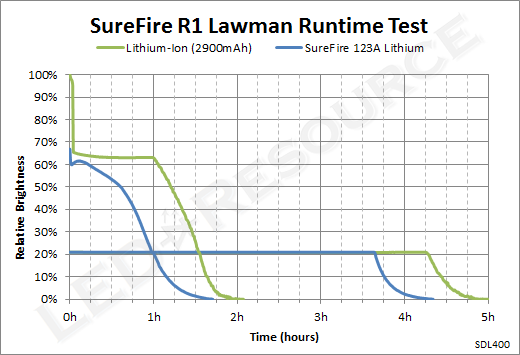
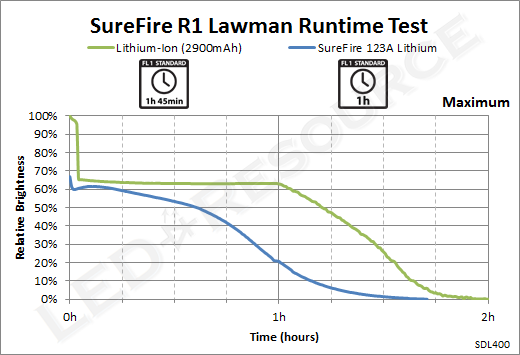
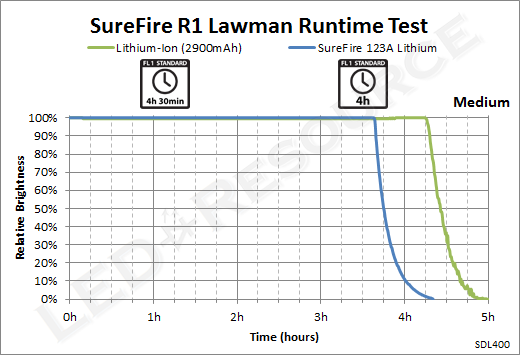
SureFire uses tactical and total runtime, which are not necessarily consistent with ANSI FL-1 Standard specifications. For the R1, maximum output runtime is given as tactical runtime (50 lumens = 7%), and lower output runtimes are given as total runtime until battery exhaustion.
When using the rechargeable battery, the R1 reduces output to 500 lumens after a 2-minute burst of 750 lumens. Due to non-linear brightness perception, the reduction during actual use is not as noticeable as the numbers seem to imply.
Accessories
Almost everything that you may need is included with the R1, including a variety of charging and battery options. One unexpected item was the anti-roll ring, which gives the R1 even more stopping power when set down on a smooth surface.
Conclusion
Whether the intended use for your flashlight is tactical or not, the SureFire R1 Lawman is guaranteed to perform in any situation where an illumination tool is indispensable. SureFire has taken a while to get the R1 Lawman just right, having gone from the original 300-lumen prototype announced at the 2011 SHOT Show, to the 700-lumen model with a one-hour runtime shown at the 2012 SHOT Show, and finally settling on a 750-lumen model with a 1.75 hour runtime for production. By combining multi-mode operation with memory and a medium output of 150 lumens, the R1 Lawman is not just extremely bright, but also convenient and practical for many uses where runtime may be preferred over output.
One aspect about the R1 Lawman is still lingering, and you might have guessed it already – price. It shouldn’t surprise those who are familiar with SureFire products, but the price is indeed quite steep compared to other rechargeable lights. That being said, the R1 Lawman has introduced a new standard for rechargeable flashlights, leaving current models comparable only to the R1’s medium mode, so there’s definitely a cost associated with all of this new technology. There’s no doubt about the R1 Lawman when it comes to features and performance, but we can’t say the same about the pricing as we did with the P2X Fury. While the SureFire R1 Lawman could be the best rechargeable flashlight that money can buy, we’ll have to leave it up to your budget or equipment allowance.
| Pros | Cons |
|
|
Related Links

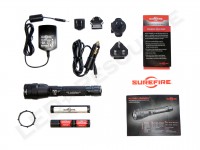
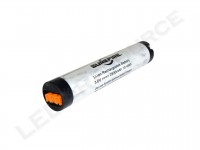
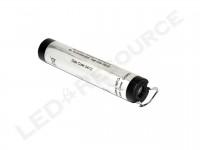
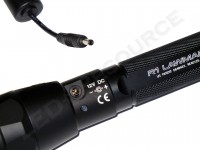
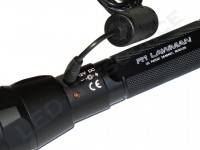
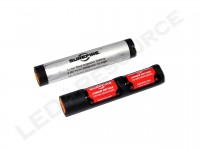
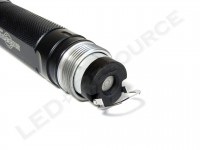
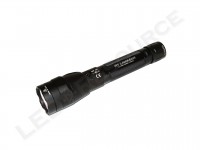
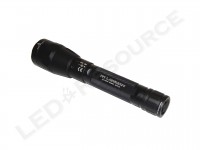
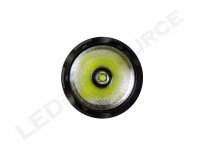
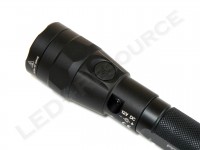
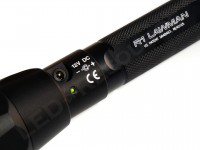
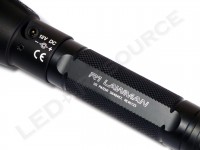
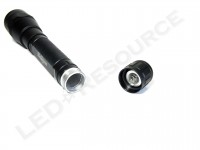
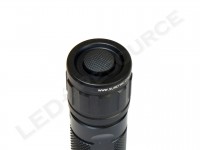
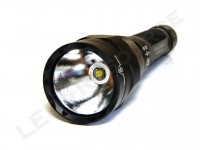
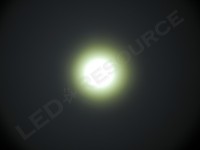
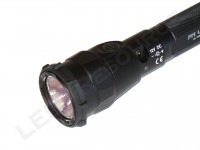
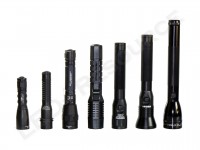



Thank you, Robin Wang, for your excellent and informative review. Your review led me to purchase the R1 Lawman light and I expect delivery today. This is my first SureFire product purchase and I’m expecting top-notch performance, reliability and durability. I have contacted SureFire support and inquired when the company expects to offer its “proprietary rechargeable lithium-ion battery pack” to the general public as an accessory purchase for the R1 Lawman. I’d also like to add a beam diffuser to gain a bit more flood when desired. Perhaps SureFire will confirm thhat the FM14 beam diffuser is compatible with the R1 Lawman’s 1.62 inch bezel. I honestly think this flashlight has hit the mark.
Paul,
You’ll enjoy your R1 Lawman! Spare batteries will be available in the near future, but I don’t have any details on when, or what the price might be.
Hope this helps.
Robin
“When using the rechargeable battery, the R1 reduces output to 500 lumens after a 2-minute burst of 750 lumens.”
Robin, I tried to replicate the lumens reduction you noted in your splendid review. Honestly, I was not able to decern a reduction…
even after 3 minutes. However, my R1’s rechargeable battery was not in a freshly charged condition when I attempted to replicate so perhaps my light was already putting out only 500 lumens. I’ll try to replicate this reduction when the battery is fully charged. Regardless, this “reduction” is not an issue for my general use needs.
And yes, I am enjoying the R1 Lawman. I even ordered a second R1 for my wife…she loves it and uses it! We both like the head switch and the fact the flashlight turns back on in the mode you last utilized.
By the way, SureFire’s proprietary rechargeable lithium-ion battery stick will be known as the “B10” if the information I have is correct.
Paul,
Reduction to 500 lumens happens even if the battery is not fully charged, but it’s not as perceivable as the numbers seem to imply. Our eyes are much less sensitive than a light meter, so it usually requires a factor of 2 increase/decrease for it to be noticeable (and a factor of 4 to appear twice as bright).
However, the difference in power consumption is significant, so that’s definately motivation for the reduction.
Robin
If I understand you correctly, then the SureFire UDR Dominator with a 2000 lumens output would, roughly speaking, appear to be twice as bright as the R1 Lawman. Glad to have a better understanding now. Thanks!
Not necessarily, perceived brightness is related to peak beam intensity (measured in candela), which can be independent of total light output (measured in lumens). I forgot to mention that since we were comparing different output levels of the same light.
Peak beam intensity depends on optical characteristics (shallow textured reflectors would have less candela than deep smooth reflectors), and total light output depends on the LED (it can be thought of as how much light is available to disperse). There’s more info about this in our ANSI FL1 Standard article (link is at the very top) under “Interpreting the FL1 Standard.”
Basically, the idea is that we have to compare peak beam intensity, not light output, to determine how “bright” it will appear. Furthermore, brightness is perceived non-linearly, hence a 4x increase in intensity to appear twice as “bright” (roughly speaking). If we compare peak beam intensity, the UDR is 165,000 cd and the R1 is 16,000 cd. Notice how there’s 10x more intensity, but only 2.6x more output, due to differences in optics (bigger smooth reflector in the UDR). Since it has 10x the intensity, it will appear approximately 3x as “bright.”
I put bright in quotes because it’s not a scientific measurement, thus hard to quantify. Hopefully, this hasn’t confused you even more…
Robin
Then is it correct to assume that with all things being equal, the newer version SureFire T1A Titan’s 100 lumens maximum output will not be perceived as particularly “brighter” when compared with the 70 lumens version? Perhaps that question is for another time. Thank you for your multiple explanations.
It will be appear a little bit brighter, as a 43% increase is significant for 70 lumens, but it will not appear “43% brighter.”
A multi-mode light demonstrates this well, so if I am explaining this in-person, I just use the Streamlight Stinger DS LED. It steps through 100%-50%-25%-50%-100% with the switch pressed, and you can see that 50% is not as low as you would expect.
Robin
Robin, I attempted to measure the output reduction of the R1 Lawman while the light was in its HIGH mode with my Pextax Digital Light Meter. I took five separate spot readings at 10, 30, 180, 240 and 300 seconds and the meter displayed the same reading at each interval. The meter was measuring the R1’s reflected light beam off a white wall from a distance of 6 inches. I guess I just don’t have the correct equipent to measure the lumens reduction.
Photography light meters are probably specialized, so I’m not sure what it is measuring. To get good readings, you need to have a controlled environment and should be measuring in lux. It’s also possible that the R1 is too bright, so you’re just getting the maximum value that the meter can output.
Robin
The Pextax Spot Meter measures EV (exposure value) for film rated at ISO 100. I’m a long way from an integrated sphere setup. I’ll keep reading on the subject and thank you for all your input.
Excuse me, I should have typed calibrated “integration” sphere.
EV can be converted to lux, but it’s very rough (each 0.5 EV is about 40% more lux). If you have a controlled environment (ie. shine the light into a small box) and keep the EV values low, you might be able to detect it.
Robin
Anyone found a legit polymer holster for the r1 lawman?
Daniel,
There’s a problem with holstering the R1 – aggressive knurling, which can wear out bezel-down holsters that use a plastic clip.
Since the R1 is similar in size to other mid-size lights, you don’t necessarily need to use one designed specifically for the R1. I’m using a Pelican 7060 holster that carries the R1 bezel-up, and it works well.
Robin
Robin, the R1/R2 Lawman User Manual states: “The light may be left plugged into the charger without damaging the battery.” The first time I read that, I thought that meant that you could leave the charger plugged into wall current without any concern of damaging the battery. I’m not so sure that is actually the case. As good practice, I always unplug the charger when the fuel gauge LED turns green. However, what happens if I simply forget to unplug the charger from the wall? Do the batteries continue to charge and is a dangerous situation therefore created? Bottom line, does this charger automatically stop charging the R1 at a certain point if left plugged into the wall current. Thanks.
Paul,
Having that statement is standard practice for lithium-ion batteries, and it simply means that the charger won’t overcharge the battery.
That being said, it could reduce the battery’s life. Many chargers apply a small trickle (or topping) charge to keep the battery fully charged. For this reason, some people remove their laptop batteries when working on AC power (which is an unnecessary practice because battery age, temperatures, and regular use are more significant contributing factors).
With the R1, there’s another caveat. SureFire said that the Fuel Gauge LED turns green at 90% charge, and after another two hours, the battery will be fully charged to 100%. Its battery is rated to 500 full charge cycles, and if you don’t make full charge/discharge cycles, you can get up to 2000 cycles.
In short, you’ll be fine keeping the R1 on the charger, but because of the charging behavior and trickle charge, I would try to disconnect the charger when the Fuel Gauge LED turns green so that you can get maximum life out of your battery.
Robin
R1 will quickly decrease its output when engaging HIGH mode if Fuel Gauge LED is indicating yellow (orange). If R1’s battery is then charged to 90% capacity (green) and HIGH is engaged, perceived light output remains constant. Is this what is referred to as “regulated” output? Thank you.
Paul,
Regulated output means that it’s not direct drive, but it doesn’t imply anything about the shape of the runtime plot. For the R1, regulated output is the first hour of output at 500 lumens.
If the Fuel Gauge LED is orange, you are probably beyond the regulated output zone, so it cannot maintain 750 lumens. Even though 750 lumens and 500 lumens almost look the same to our eyes, there’s a significant difference in power consumption.
Robin
Armed with your update at CPF that the use of LFP 123A batteries renders the tail switch inopperative and causes the LED Fuel Guage to blink red in a pre-June 2012 R1, may I still operate the Lawman R1 utilizing its head switch (only) without experiencing output issues? Thank you.